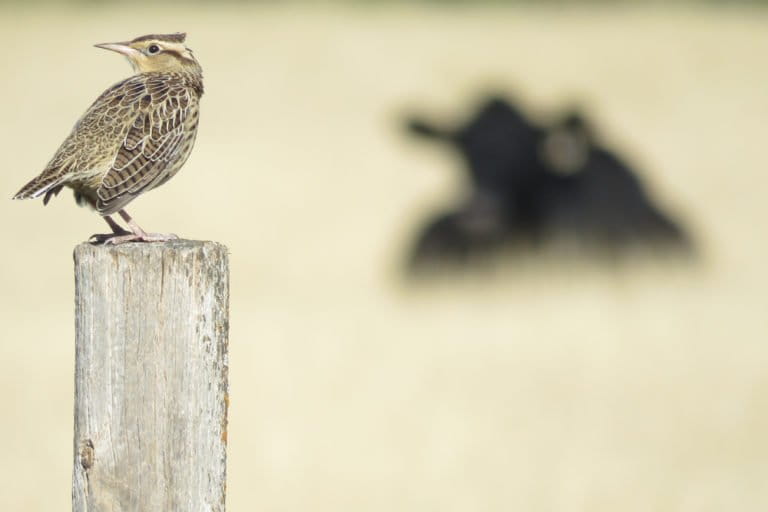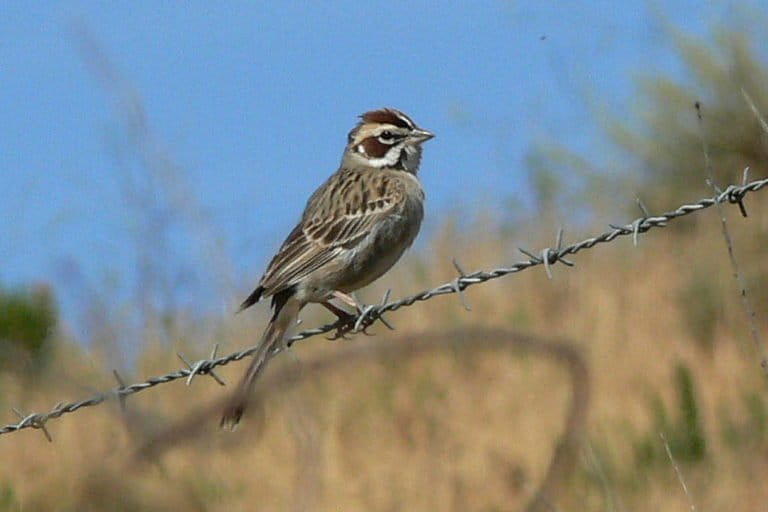- Landowners and the National Audubon Society have partnered over the past six years to restore rangeland from Texas to the Dakotas.
- The conservation ranching program targets bird species in peril in 13 states.
Juncos, blackbirds, meadowlarks and other common species comprise two-thirds of the 3 billion birds lost in the last half century, a decline scientists have likened to that of the now-extinct passenger pigeon. Yet they thrive on Dusty Downey’s ranch.
His fourth-generation cattle operation on northeastern Wyoming’s shortgrass prairie is home to 78 species of birds, including dark-eyed juncos (Junco hyemalis), red-winged blackbirds (Agelaius phoeniceus), and western meadowlarks (Sturnella neglecta
Downey is among 82 ranchers from Texas to the Dakotas using protocols designed by the National Audubon Society to reinvigorate grassland ecosystems to increase populations of imperiled birds. In exchange, landowners get to place a green seal on their products that, in some cases, have boosted profitability by 10%, according to Audubon. The seal reads, “Grazed on Audubon Certified Bird Friendly Land.”
“This market-based approach is very powerful — we’ve used the certification to sell directly to consumers we wouldn’t have been able to before,” Downey, who is also Audubon Rockies’ conservation ranching lead, said in a phone interview.

Part of the program’s economic appeal comes from the 115-year-old nonprofit’s ability to market products raised on enrolled ranches to its more than 1.7 million members, he added.
The initiative, which has been running for six years, transcends geographic, class and political lines. About seven dozen U.S.-based ranchers who are already participating own and manage a combined 890,000 hectares (2.2 million acres) of land throughout 13 states. They work with conservationists and scientists to devise plans to improve native plant communities that struggling bird species rely upon to reproduce.
These plans, designed to adapt to changing weather patterns, prescribe rotational grazing, invasive plant control, and building water infrastructure. An independent third-party verification specialist must agree that the plans improve productivity and rangeland bird habitat.

The program is ramping up at a critical time. Grasslands are considered the most endangered habitat in North America, with less than 40% of the 220 million hectares (550 million acres) that once stretched from Alberta to Mexico remaining. Development or tilled farmland took their place, plowing under short, tall and mixed grass species many birds rely on to thrive.
Habitat loss and fragmentation contributed to a 53% decline in grassland birds since 1970 — or 700 million feathered creatures. These were the steepest losses charted in a ground-breaking 2019 study published in Science magazine that focused the world’s attention on avifauna’s plight.
The peril is so immediate that government agencies, conservationists, tribes, industries and landowners from Canada, Mexico and the United States plan to meet in August to develop a framework to preserve grasslands for migratory birds. Such cooperation is crucial because birds visit many regions each year.
“A lot of this is out of our control, because many birds winter in Mexico, so if something is going on in Mexico it can impact populations that come here in the summer,” Alison Holloran, executive director of Audubon Rockies, said in a phone interview.
Other nonprofits are also cooperating with private landowners to improve both ecosystems for birds and agriculture operations across landscapes.
“There’s been a great shift in how landowners are looking at their land and the things they are considering,” Lauren Connell, stewardship director for the Bird Conservancy of the Rockies, said in a phone interview.

Wildlife biologists with the conservancy used federal funding and grants to restore ecosystems across 715 projects on private land in six states since 2008. Audubon employs the nonprofit’s monitoring protocol when it conducts annual bird surveys on ranches in its conservation program.
During breeding season, scientists with Precision Wildlife Resources LLC count birds for six minutes in grids 250 meters (820 feet) apart to assess diversity and abundance. With just six years of data, there is not enough evidence to say if the Audubon program is significantly increasing populations.
“We can’t definitively say yet that our techniques on ranch X, Y or Z have boosted horn lark populations by 10%, for example,” Holloran said. “We expect after 10 years we might see some increase in populations.”
Collecting reliable data on bird populations takes time because they are so mobile and it’s difficult to obtain large, consistent sample sizes. The nonprofit also conducted nesting surveys on a dozen ranches in Colorado and Wyoming in 2019 to supplement bird surveys.
Anecdotally, ranchers say their efforts to improve ecosystems are paying off. These landowners noticed more birds after implementing time-intensive rotational grazing, which requires moving cows to new pastures every so often and hemming them in with electric fencing. Such practices prevent overgrazing and subsequent erosion. Cattle operators caution that they’re not sure if the practices are increasing bird populations, or if they’re just more aware that the birds are there than they were before.

“They’ve done bird surveys the last three or four years and I was surprised by how many species are out there,” Tom Reed, whose family runs 1,000 Rambouillet sheep and 150 Black Angus cows on their ranch in Wyoming’s Thunder Basin, said in a phone interview.
“There are these little brown birds that flit through the sagebrush and they are really hard to get a good picture of,” added Reed, who has filled his phone gallery with bird and egg photos and is trying to learn their songs.
Those birds are vesper sparrows (Pooecetes gramineus), among 69 species found on the 73-year-old ranch where the sagebrush sea meets the shortgrass prairie, including several listed as “species of greatest conservation need” by the Wyoming Game and Fish Department, such as loggerhead shrikes (Lanius ludovicianus) and Brewer’s sparrow (Spizella breweri).
Reed said he isn’t yet making money off the Audubon seal he places on his grass-fed beef, largely because he cannot move enough volume, in some cases due to coronavirus-induced closures at beef processing plants.
Corner Post Meats, which distributes beef, turkey, pork and lamb grown on its 639-hectare (1,579-acre) facility near Monument, Colorado, as well as on other Audubon-certified ranches, is still trying to catch up from a pandemic-related boom.
Adrienne Larrew and Dan Lorenz, who lease Kiowa Creek Ranch from Audubon Rockies, did two weeks’ worth of sales in one day when restaurants closed in mid-March. Receipts in April remained up by triple digits as customers looked for alternatives to grocery store shelves ravaged by panic buying.
Western meadowlarks and lark sparrows (Chondestes grammacus) are among 100 species observed on the property in the Black Forest, sandwiched between Denver and Colorado Springs. The acreage boasts ponderosa pines, the headwaters for several tributaries, and wetlands frequented by mallards (Anas platyrhynchos), sandhill cranes (Antigone canadensis) and other waterfowl.

Larrew and Lorenz focus on high-intensity, short-duration grazing on small pastures that mimics “large migrating herds of ruminant animals,” such as bison, to encourage the health of the soil, grasses and nutritious flowering plants, according to the ranch’s habitat management plan. The ground then rests for several months.
The program targets habitat needs of specific birds such as lark buntings (Calamospiza melanocorys), which prefers light grazing in the summer to maintain taller vegetation to shade its nest and nurture grasshoppers. The couple also works with forestry officials to clean up trees burned in the Black Forest fire in part to provide park-like groves preferred by the northern goshawk (Accipiter gentilis).
Larrew and Lorenz seek to educate consumers that eating meat is not bad for the environment and that, when done properly, ranching can ensure the land provides habitat for a variety of animals. They’re starting with the neighbors.
“People are saying ‘stop logging, stop grazing, there are goshawks there,’” Lorenz said. “We need to flip people’s brains that logging can be good and grazing can be good — that bird agrees with us because he wasn’t here before.”
Banner image: A western meadowlark joins a Black Angus on Downey’s ranch. Image courtesy Downey family.














